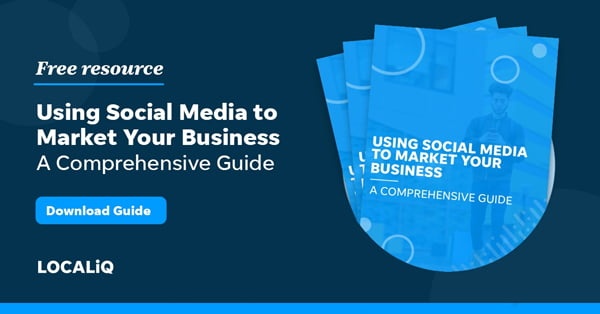Social media algorithms use calculations to sort and tailor content for individual users. Algorithm metrics vary depending on the platform, but they sort content by relevance, usefulness, chronology, and more. Algorithms are becoming more sophisticated over time, and they are continually adapted to improve the personalisation of content for users.
It can be disheartening for content creators and business page owners who may feel like their content doesn’t receive high levels of engagement or views, but there are ways that you can optimise your content to improve the chances of your content being viewed by a bigger audience. It’s vital that you stay up to date with any algorithm changes so that you can adapt your content.
How to Use Social Media to Market Your Business
Learn the fundamentals of social media marketing with our free, comprehensive guide.
Why do social media platforms use algorithms?
Before social media algorithms were introduced, most social media platforms displayed content in order of recency; the newer the post, the higher it would appear on the homepage. Using social media algorithms means the masses of content posted to social media platforms are filtered and personalised for each user. This ensures that they keep coming back to the platform to see content that they enjoy.
The benefits of social media algorithms
- Personalisation
Social media algorithms are designed to show users exactly what they want to see. Algorithm rules match posts with the interests of social media users, which provides a more enjoyable user experience because they can discover posts that are useful and catered to them.
- It can help you grow your audience
Once you have established how you are going to optimise your content, the algorithm can benefit you by helping you grow your audience. If you make content for users who are interested in a particular niche and you focus on using the correct hashtags and posting relevant, useful content, it’s likely that the algorithm will show your content to wider audiences, and users who frequently engage with your content won’t miss any of your posts.
- Staying in the loop
Whilst social media today is used for more than just staying connected to people you know online, most social media algorithms still make sure that close connections take precedence. The algorithm will ensure that posts made by a user’s friends or family members appear at the top of their feed, meaning they never miss out on what may be important to them.
The disadvantages of social media algorithms
- Organic Reach
Social media algorithms have made it harder for users to find posts that they may have found interesting if they had searched for it organically. This means that unless you conform to the algorithm’s methods of sorting content, you may find that your content gets less reach than you expected, and your followers may not see your posts.
- Feeling ignored
You may think that your content is frequently ignored even when you try your best, or that the algorithm may be biased against you. Whilst social media platforms continually tell us that this is not true, it’s best to stick to best practice when producing social media content to make sure that you’re not wasting time making content that nobody will see.
- Time consuming
Before social media algorithms came into play, having great, relevant content used to be enough to gain lots of new followers and interactions. Now, making sure that your content is optimised for social media algorithms is just as important as the quality of your content, and this can be time consuming. However, doing so will vastly improve your chances of reaching a wider audience.
Social media platforms and algorithms
Facebook is the world’s biggest social media platform, with over 2.85 billion monthly users and 200 million business pages. Having a Facebook business page is imperative to a successful social media presence for your business, and it’s important that you know how the algorithm works.
How does the facebook algorithm work?
The facebook algorithm judges content by four main factors:
- Relationships
- Content type
- Popularity
- Recency
Facebook values relationships above all else when ranking content. When users open their homepage, the posts at the top of their feed will be posts by other users they frequently engage with. Facebook’s algorithm determines these relationships by analysing who you are communicating with in the comments section, who you are tagging in posts, and who’s content you are liking and sharing.
Facebook allows users to have some control over their feed with features like: see first, hide, unfollow, and why am I seeing this? Users can pick which user’s content they want to see at the top of their feed, and they can indicate whether they want to see less of another.
The Facebook algorithm assesses all the posts in your network, and ranks these posts by type of post, recency, and usefulness. It automatically filters posts that it assumes you will not want to see based on your prior interactions and behaviour. Recently, a fact checker feature has been implemented, so that posts from news sources or official pages can be validated, and clickbait, violent, or unhelpful content is filtered out.
Then, it personalises the remaining content by judging which pieces of content you are more likely to engage with, e.g., a photo from one of your connections, or a video from a business page you have engaged with before. When users are shown content from pages or groups, the algorithm prioritises the kind of content that you might share with your friends, such as a rich media post that has a large discussion in the comments section.
Finally, it tries to mix up the remaining posts, so that users have a dynamic and varied feed to scroll through, aiming to keep users scrolling for as long as possible.
How to beat the facebook algorithm
There are several ways that you can maximise your content for the algorithm’s standards:
- Keep up to date
The algorithm is constantly being updated, and most social media platforms have an annual algorithm overhaul, where they announce restructures to their algorithms. You can check Facebook’s news page to keep up to date with any changes made to the platform.
- Interact with your audience
Create conversations with your followers; ensure that you keep an open dialogue and post content that they can interact with and share, e.g., polls, quizzes, and rich media content. The more that your audience engage with you, the higher the Facebook algorithm will prioritise your posts on their homepage.
- Timing
It’s easy to find out when your audience are most active using the Facebook business tools insights feature. Find out when they are online and what they are interacting with, and make sure you are posting good, similar content frequently and at the right times to receive maximum engagement.
- Go live
Going live on Facebook can be a great way to be interactive with your followers. Live events like webinars drive more traffic than static videos and offers a dynamic interaction for your followers where you can chat directly to them and answer their questions in real time.
- Use Facebook stories
Facebook stories hover at the top of the homepage, and don’t get sorted by the algorithm. This is a great tool to post quick snippets for your followers to engage with, or to entice them to find out more about your company. You can post stories frequently without spamming your followers’ homepages.
- Create quality content
Post fun, informative, engaging, interesting content. Facebook prioritises keeping the platform ‘social’ – the algorithm will favour posts with an authentic voice and posts that people will want to see and connect with. Focus on the quality of your content, and ask yourself: is this the kind of content you would want to see as a consumer?
Twitter is known for being a fast-paced platform with thousands of tweets being shared every minute, so for many years, Twitter’s dashboard showed tweets in order of recency. Now, users can choose whether to stick to the original formula, or whether to go for the optimised dashboard, where ‘top tweets’ that the algorithm has determined will be of interest to the user show up first. Users can also follow Topics, such as politics or gaming, and tweets that are relevant to those topics, and have gained a lot of traction, will appear on the user’s homepage even if they do not follow the original tweeter.
Different types of feeds
- Top tweets
Top tweets are determined by a few factors, such as: the number of likes/retweets that the tweet has gotten, relevance, whether people you follow have interacted with the tweet, if the tweet contains rich media (such as gifs or videos), if you have previously liked this user’s tweets, or if it is related to topics that you frequently interact with or have specifically searched for.
- Latest
The Latest tweets dashboards shows tweets in real time. However, the algorithm still has a say in what tweets make the cut; whilst it will show most tweets in order of recency, it knows how to filter spam tweets, and will still prioritise tweets by the users you follow and interact with.
How to beat the Twitter algorithm
- Timing
Twitter is fast paced, so you need to tweet frequently to appear on people’s dashboards. Make sure you are tweeting consistent, fresh content, but be careful not to tweet too much, as they may be filtered as spam.
- Use rich media
Not only is using gifs, photos, or videos favourable for the algorithm, but users also find these tweets more engaging; the visual element breaks up the endless stream of tweets. Users are much more likely to engage with this kind of content, and it will make your tweets stand out.
- Use engagement tools
Make sure that you utilise all the engagement tools, such as polls. These tools can make your tweets more interactive, and you can use polls to find out more about your audience’s likes and dislikes.
- Hashtags
Using hashtags mean your tweets can be found by users searching for topics that interest them, which could potentially grow your follower count. Tweeting hashtags related to trending topics and conversations opens the potential to make the Top Tweets section of that hashtag. Make sure not to use too many, and don’t use hashtags that don’t align with your brand, as this can negatively impact your social media presence.
Whilst Instagram used to be for sharing images, over time, the app has added newer features such as stories, reels, and IGTV. Instagram posts on the main feed and the Explore page, featured stories, and reels are all judged by algorithm. Whilst the Instagram feed used to be in reverse chronological order, it now predicts what users will find the most interesting and shows that first.
What is the Instagram algorithm looking for?
- Who posted it?
The Instagram algorithm prioritises the relationship between users when organising a user’s feed. If a user regularly watches, likes, saves, or shares the content of another user, it’s likely that their posts will show at the top of their feed.
- Quality content
Certain types of content, such as a carousel post (multiple images strung together in a swipe-through post) will perform better than others, because they encourage more interaction and longer dwell-time. The Instagram algorithm also considers what style of content a user likes; does the user frequently watch videos? Do they watch IGTV episodes? If so, these types of posts will appear on their feed more often. If you’re a sport lover who checks for team updates via Instagram, or if you love browsing through the explore page for fashion inspiration, the Instagram algorithm will adapt to show you this type of content more often.
- Recency
Instagram posts used to appear in reverse chronological order on the main feed, and whilst this is no longer the main factor for feed arrangement, the recency of your post still counts; newer content is more likely to appear on a user’s feed.
- Follower activity
If your followers frequently check Instagram, they will be shown newer content more frequently so that they aren’t scrolling through old content they may have already seen. If they are infrequent scrollers, the algorithm will have more posts to comb through, meaning less chance of your post breaking through to the top.
- Who your followers follow
If your followers follow lots of accounts, it will determine what accounts they engage with frequently, and will prioritise these posts. If they follow pages like yours, your posts may appear on their Explore page. If someone follows 500 accounts, they will see less content from you than if they only follow 100.
How to beat the Instagram algorithm
- Types of posts
Look at your previous content; what types of posts did your followers engage with the most? Which posts got the most comments, or likes? Have a look at other Instagram business pages in your market; what types of posts are successful for them? Can you create this type of content?Try something new; for example, try posting a carousel, which lets you expand on a topic or image and give your audience more information without clogging up their homepage. You can use carousels to tell a story, or make a swipe-through guide, or you can group images together that would not normally need their own posts.
- Consistency
Make sure you are posting consistently. If you post too much, you might bore or spam your audience. Post too infrequently, and the algorithm won’t promote your content to the top. Frequent posting will improve your reach and will ensure your followers don’t forget about you; 4-5 posts a week will keep your account consistent but not spammy.
- Planning
As well as keeping your content consistent, make sure you create a social calendar, as this will provide a structure for your posts. Plan out when to post, what to post, captions, hashtags, and the look of your overall feed so that you are in keeping with your brand style.
- Utilise all the features of Instagram
Stories: Stories appear at the top of a user’s homepage, meaning they are accessible and more likely to be viewed. Stories are great for posting lots of content without spamming your followers’ homepages and can help you get creative with your posts. Use stories to remind your followers when you have shared a new post. Add a swipe-up to your stories to direct your followers to your website. Engage with your followers by creating polls or find out more about them using the questions feature. Stories only last for 24 hours, but you can then save them to your highlights which will appear on your profile. This is a great way to showcase your best content, or to bookmark important posts your followers might want to access quickly when they go on to your page.
Reels: Reels are short snippet videos that you can use to communicate with your followers in a visually engaging way and show off your brand or products. Unlike stories, they won’t disappear from your feed.
IGTV: IGTV lets you upload unique long-form videos of up to 60 minutes, instead of the 60 second limit imposed on feed videos. You can use IGTV to share information with your followers in a webinar format, for promotional videos, or you can use them to share a walkthrough or tutorial. Use IGTV to familiarise your followers with the people behind the content; featuring real people gives an immersive, TV-like experience. You could even create an episodic series to keep your followers returning to your page. Unlike YouTube, there are no adverts to break up or distract from your content.
Guides: Instagram guides were introduced last year as a way for users to share longform content. The feature was originally granted to accounts that focus on mindfulness and wellness to share resources with their followers, but now any user or business account can create guides. Use the guides feature to create blogs, lists, step-by-step tutorials, or to show off your products or services. Like Reels and IGTV, Guides will stay visible on your Instagram profile.
Live: Try going live on Instagram to interact in real-time with your followers. You could host a FAQ session, or just respond to messages in your live feed. By going live, your followers get to see the real people behind your brand, which can improve brand loyalty. In 2021, Instagram released the Rooms update, meaning that now you can go live with other businesses or Instagram users; this allows you to collaborate with others and share your audiences.
- Tags and hashtags
If you’re a local business, tag your location so that your followers know where to find you. For example, users looking for a new coffee spot may use the location feature to find somewhere close by, so make sure you put yourself on the map. Users may also search hashtags to find a particular product, e.g., if someone is looking for a red backpack, they may search the #redbackpack hashtag, so they can find business who make what they’re looking for. Keep it relevant; correctly tagging your posts will boost the likelihood of your posts being promoted on the explore page, a great way of gaining exposure and increasing your follower count. Be careful not to use too many hashtags; 1-3 hashtags in your post captions should be enough.
Unlike other social media platforms, LinkedIn doesn’t share the details of their algorithm, which can make it difficult to predict. However, there are a few basic ways that you can optimise your posts that may increase the engagement of your posts.
How to beat the LinkedIn algorithm
- Make it engaging
Make sure that your audience engages with you. Create and share content that is interesting, and makes your connections want to comment or interact. Sharing a funny or inspiring anecdote, or providing useful tips is a great way to get your audience chatting on your posts. Your connections that frequently engage with you will be shown more of your posts, as LinkedIn values showing their users content that interests them.
- Rich media
Whilst LinkedIn used to favour videos, this is no longer the case. However, it’s still important to make your posts dynamic and easily digestible, and using video or photo is a great way to make scrolling through the homepage more interesting for your connections.
- Comments
Comments are more important than interactions; whilst it’s good to share content that you think your connections will like, you want to make sure you get the conversation started. Create a dialogue with your connections by asking questions in your posts, or by encouraging connections to tag users who may be interested in your content to expand your reach.
- Dwell time
One of the metrics that LinkedIn considers when prioritising posts is dwell time. If your connections only spend a few seconds glancing at your previous posts, it’s unlikely that LinkedIn will show your newer posts at the tops of their homepages. However, if you share valuable content that your connections spend time reading and digesting, LinkedIn will make sure that they continue to enjoy your posts by bumping your content higher up on their homepage.
- Know your audience
As LinkedIn is a professional social media platform, it’s likely that most of your connections will be active between typical workhours on weekdays. Make sure that this is when you schedule your posts, as most LinkedIn users won’t be checking their professional social media pages on the weekends or out-of-hours.
- Avoid spamming
If you post too much, your posts may be flagged as spam. Make sure you prioritise quality when posting to LinkedIn; if your post is irrelevant to your circle of connections, it will be less likely to show up on the homepage.
TikTok
For those hoping to go viral on 2020’s most downloaded app, they may have to jump through a few hoops first. A platform for sharing short, snappy videos, TikTok is known for their complex algorithm that curates a highly personalised, unique feed for each user. TikTok users can filter videos by two options: the carefully curated ‘For You’ page, that features suggested niche videos determined by TikTok’s algorithms, or by the ‘Following’ filter, where they can watch clips that have been posted by users they follow.
How is the TikTok algorithm determined?
- Interests
When users start an account on TikTok, they are given the option to select categories that they are interested in, e.g., travel or cooking. This information helps TikTok to curate the For You page for the first time before they have gathered information about a user’s watching habits. The algorithm continues to keep in mind these selected interests when deciding what videos will show up on a user’s for you page.
- Hashtags
Like most other social media platforms, adding hashtags to your content helps the algorithm to figure out what your video is about, and who it will interest. Click on the Discover tab in the app to see what hashtags are trending and racking up views and consider making content relevant to these.
- Sounds
A huge part of TikTok’s content is the sounds feature. Most TikToks feature a ‘sound’ – a clip of music, or speech, that is played in the background. Some sounds go viral and start trends, and this can be a great opportunity to get involved and find yourself a new audience. Using the video editor, you can check which sounds are popular right now; browse through the popular sounds and consider how you could implement the sound in your own content. TikTok moves quickly, so make sure that you’re not using sounds that have already lost the hype.
Understand your audience
By checking your TikTok account’s analytics, you can find out more information about your follower demographics. You can discover the gender, age, and location of your followers, and you can see when they are most active. When you know more about your audience, you can learn how to tailor your content to suit them. By knowing when your audience is active, you can make sure that you’re posting interesting content that they want to see at the times when they are most active.
Do social media algorithms work?
Now that you understand what social media algorithms are, how they work, and how you can implement this knowledge in your social media strategy, you should be able to tailor your content for your audience across different social media platforms. Whilst learning about algorithms may feel time-consuming, it is vital to kickstarting your social media presence, and it will prevent you from creating content that won’t reach the top of your audience’s homepages. Be patient; if your content does not immediately receive the engagement that you had hoped for, keep reviewing your strategies and make sure that you are up to date with algorithm changes for each platform. Set SMART goals for your content to track your progress, and always focus on making your content as relevant and interesting for your audience as possible.
How to Use Social Media to Market Your Business
Learn the fundamentals of social media marketing with our free, comprehensive guide.






